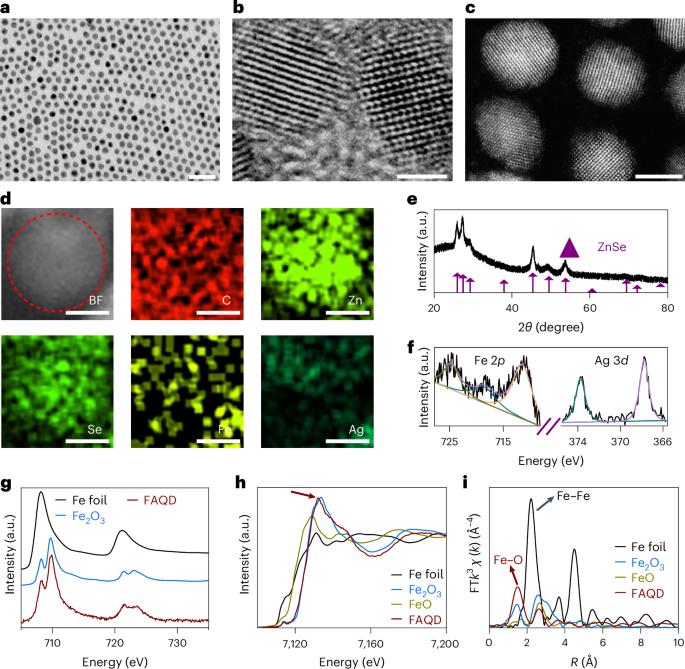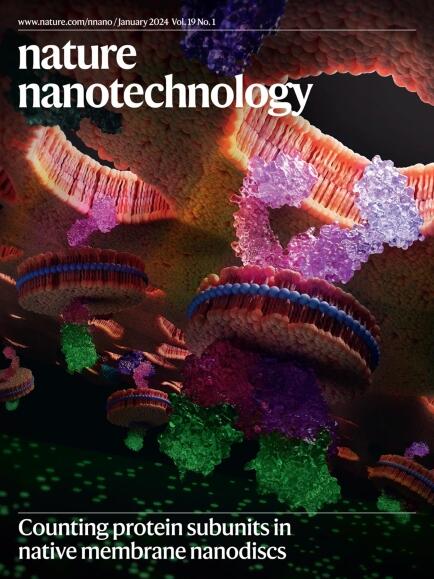Iron–silver-modified quantum dots act as efficient catalysts in anti-cancer multitherapy through controlled, ultrasound-induced oxidation
IF 34.9
1区 材料科学
Q1 MATERIALS SCIENCE, MULTIDISCIPLINARY
引用次数: 0
Abstract
Chemodynamic therapy and sonodynamic therapy are two promising tumour therapeutic strategies. However, lack of highly effective sonosensitizers and control over chemodynamic therapy limit their application. Here we synthesize silver-doped zinc selenide quantum dots with atomically dispersed superficial Fe and show that they act as efficient sonosensitizers, catalysers and immunoreagents. Surface modification with an in situ self-assembly peptide drives accumulation in tumours. Superficial FeIII remains stable and converts to FeII only under ultrasonic processing, reverting to FeIII upon ultrasound cessation. Under ultrasound stimulation, superficial Fe undergoes valence change with concomitant amelioration of the hypoxic tumour microenvironment and production of sonodynamic therapy-beneficial hydroxyl radicals. Furthermore, silver doping suppressed nonradiative recombination of excitons, leading to improved production of singlet oxygen. Meanwhile, selenium promotes robust systemic immune responses for the inhibition of tumour metastases. This nano-platform allows control of valence switching of atomically dispersed catalysts, representing an effective tool for chemodynamic/sonodynamic/immunotherapy. Atomically dispersed surficial iron in silver-doped zinc selenide quantum dots with an in situ self-assembly peptide act as efficient catalysts in anti-cancer multitherapy through controlled, ultrasound-induced oxidation.


铁银修饰量子点作为有效的催化剂,通过控制,超声诱导氧化抗癌综合治疗
化学动力疗法和声动力疗法是两种很有前途的肿瘤治疗策略。然而,缺乏高效的声敏剂和对化学动力治疗的控制限制了它们的应用。本文采用原子分散的表面铁合成了掺杂银的硒化锌量子点,并证明了其作为高效的声敏剂、催化剂和免疫试剂的作用。表面修饰与原位自组装肽驱动积聚在肿瘤。表面FeIII保持稳定,仅在超声处理下转化为FeII,在超声停止后恢复为FeIII。在超声刺激下,浅表铁发生价态变化,同时改善缺氧肿瘤微环境和产生声动力治疗有益的羟基自由基。此外,银掺杂抑制了激子的非辐射重组,从而改善了单线态氧的产生。同时,硒促进抑制肿瘤转移的强大的全身免疫反应。这种纳米平台可以控制原子分散催化剂的价态开关,是化学动力学/声动力学/免疫治疗的有效工具。
本文章由计算机程序翻译,如有差异,请以英文原文为准。
求助全文
约1分钟内获得全文
求助全文
来源期刊

Nature nanotechnology
工程技术-材料科学:综合
CiteScore
59.70
自引率
0.80%
发文量
196
审稿时长
4-8 weeks
期刊介绍:
Nature Nanotechnology is a prestigious journal that publishes high-quality papers in various areas of nanoscience and nanotechnology. The journal focuses on the design, characterization, and production of structures, devices, and systems that manipulate and control materials at atomic, molecular, and macromolecular scales. It encompasses both bottom-up and top-down approaches, as well as their combinations.
Furthermore, Nature Nanotechnology fosters the exchange of ideas among researchers from diverse disciplines such as chemistry, physics, material science, biomedical research, engineering, and more. It promotes collaboration at the forefront of this multidisciplinary field. The journal covers a wide range of topics, from fundamental research in physics, chemistry, and biology, including computational work and simulations, to the development of innovative devices and technologies for various industrial sectors such as information technology, medicine, manufacturing, high-performance materials, energy, and environmental technologies. It includes coverage of organic, inorganic, and hybrid materials.
 求助内容:
求助内容: 应助结果提醒方式:
应助结果提醒方式:


